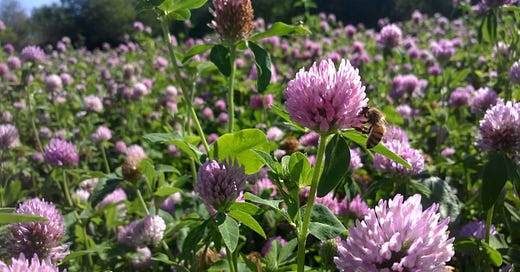Sandy: Redesigning Resilience, Demonstrating Agroecology in Action
Reflections from students of an Agroecology course at North Carolina State University
This post is by Meg Sandy, who introduces herself as follows: Meg is a student at NCSU studying Agroecology and Community Food Systems. Outside of the classroom, her love of agroecology is reflected in time spent cooking and sharing meals with loved ones as frequently as possible.
Note: This series of student posts are only lightly edited to maintain the students’ voices.
For my final Agroecosystem Design project as a student of Agroecology and Community Food Systems, my group and I chose the redesign paradigm. Rooted in the principles of transformation and biodiversity, redesign feels particularly well-suited to the context of our project site: the agroecology education farm at NC State University. As students, our approach centered on imagining the farm not just as a place for growing food, but as a tool for community empowerment, education, and ecological resilience.
Redesign asks us to shift away from input-heavy monoculture toward diversified systems that serve both people and planet. This paradigm requires creativity, intention, and iteration. Importantly, it also demands that we demonstrate what these systems can do, to make agroecology not just an academic exercise, but a lived and visible reality. That’s where the power of public demonstration comes in.
The Public Potential of a Farm
One of the most exciting aspects of our project is that our design lives within an already visible and accessible space. NC State’s agroecology education farm has community embedded in its DNA. By expanding its diversity of crops, spatial design, and ecological functions, we aim to make it even more of a living classroom, not just for students, but for the broader public.
Intercropping: Learning Through Demonstration
Central to our design is the demonstration of intercropping systems, both as a learning opportunity and a functional strategy for soil health and biodiversity. We’re planning to showcase 2–3 intercropping systems that are culturally significant to North Carolina or represent practices relevant to different regions of the state.
Our featured systems include:
La Milpa (Three Sisters): A traditional intercropping system combining maize, beans, and squash. This system exemplifies nutrient cycling and spatial layering.
Beans (snap or pole): April 1 – October 1
Sweet corn: March 15 – June 1 (or April 15 – June 1, depending on the variety)
Summer squash: April 1 – August 15
Sunflower and Sweet Potato: This pairing highlights Eastern NC’s sweet potato culture while showcasing spatial complementarity. We opted to exclude a third crop like peanuts due to competition for nutrients and space.
Sunflower: March 15 – May 15
Sweet potato: May 1 – July 15
Additionally, we’re integrating leguminous cover crops into the system for their regenerative properties. Legumes replenish nitrogen availability, reduce erosion, increase biomass, and stimulate healthy microbiological activity in the soil.
Building Soil and Ecosystem Health with Cover Crops
To further demonstrate ecological management, we’re incorporating cover crops with the dual purpose of soil regeneration and pollinator support. Our priorities in selecting cover crops include:
Increasing soil organic matter (SOM)
Improving soil aggregation
Providing habitat and nutrition for pollinators and beneficial insects
We chose:
Red Clover: Best for pollinators and strong for nitrogen fixation, SOM and aggregation. Optimal planting: October 20 – November 15. It’s usually seeded between two non-leguminous crops, often frost-seeded into winter cereals.
Winter Cereal Rye: Excellent for suppressing summer annual grasses and boosting SOM and aggregation. Reliable establishment windows: February 25 – March 15 or October 20 – November 15.
By planting these cover crops, we reduce the need for tillage and chemical weed control, while also enhancing the biological complexity of our farm system.
Demonstrating Pest Management Beyond the Spray
Our pest management strategy embraces Integrated Pest Management (IPM) and focuses on prevention, monitoring, and biological suppression, rather than reactionary chemical use. Following the PAMS model (Preventative, Avoidance, Monitoring, Suppression), we will incorporate pest traps, diversified crop placement, and beneficial insect habitats. These approaches make ecological pest control visible and understandable to visitors, breaking the myth that only synthetic inputs can ensure plant health.
Connecting to People: Community and Markets
Beyond production, our system is designed to engage people. Trees will provide shaded gathering areas and places for reflection or conversation. Informative signage will explain the relationships between crops, the purpose of cover crops, and the ecological thinking behind every design decision.
Redesign in Action
Every layer of our system, from the intercropping layouts to the cover crops, from fruit trees to compost applications, is grounded in the redesign paradigm. This paradigm emphasizes transformation, resilience, biodiversity, and multifunctionality. We’re not just improving outputs, we’re improving the relationships within the system itself.
Most importantly, redesign is meant to be demonstrated. Seeing a living agroecological system in action changes perceptions. It invites questions. It shows that agriculture can be regenerative, collaborative, and deeply rooted in place.
A Question for Readers
What’s one small way you think your local community could benefit from seeing or engaging with agroecological practices? Whether through food, education, or shared space?








Great question Meg. I am often wondering how to have more of any local community see or truly understand what goes on at the farms where they get their food, especially if the farms are local. I don't think short chats at a farmer's market or pick-your-own days really show customers the realities of farming. I'm never sure what would work, that is also actually practical for the farm (they can't have neighbors shadowing them at random times!). Maybe demonstration farms like you have at NC State are part of the answer. Maybe there is a way for farmers to share more, on their own terms, through talks or video or writing or...something?